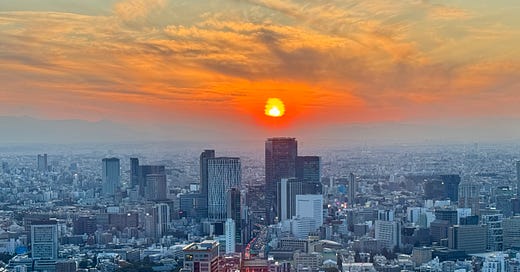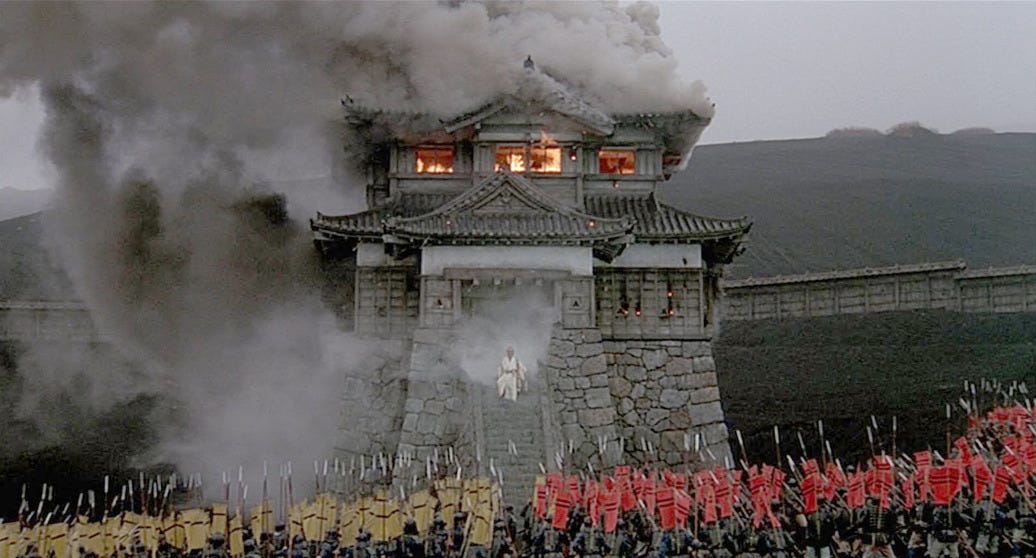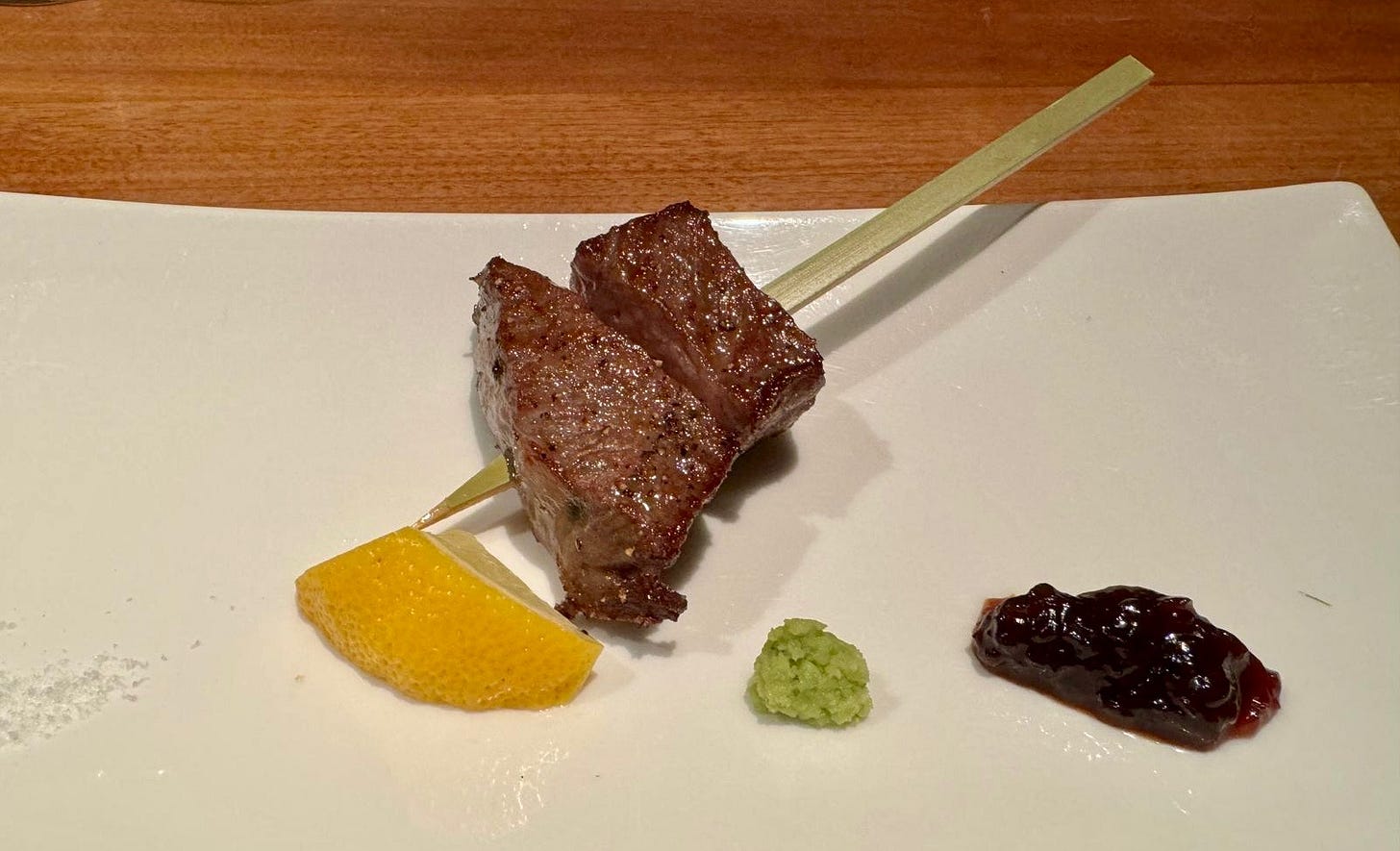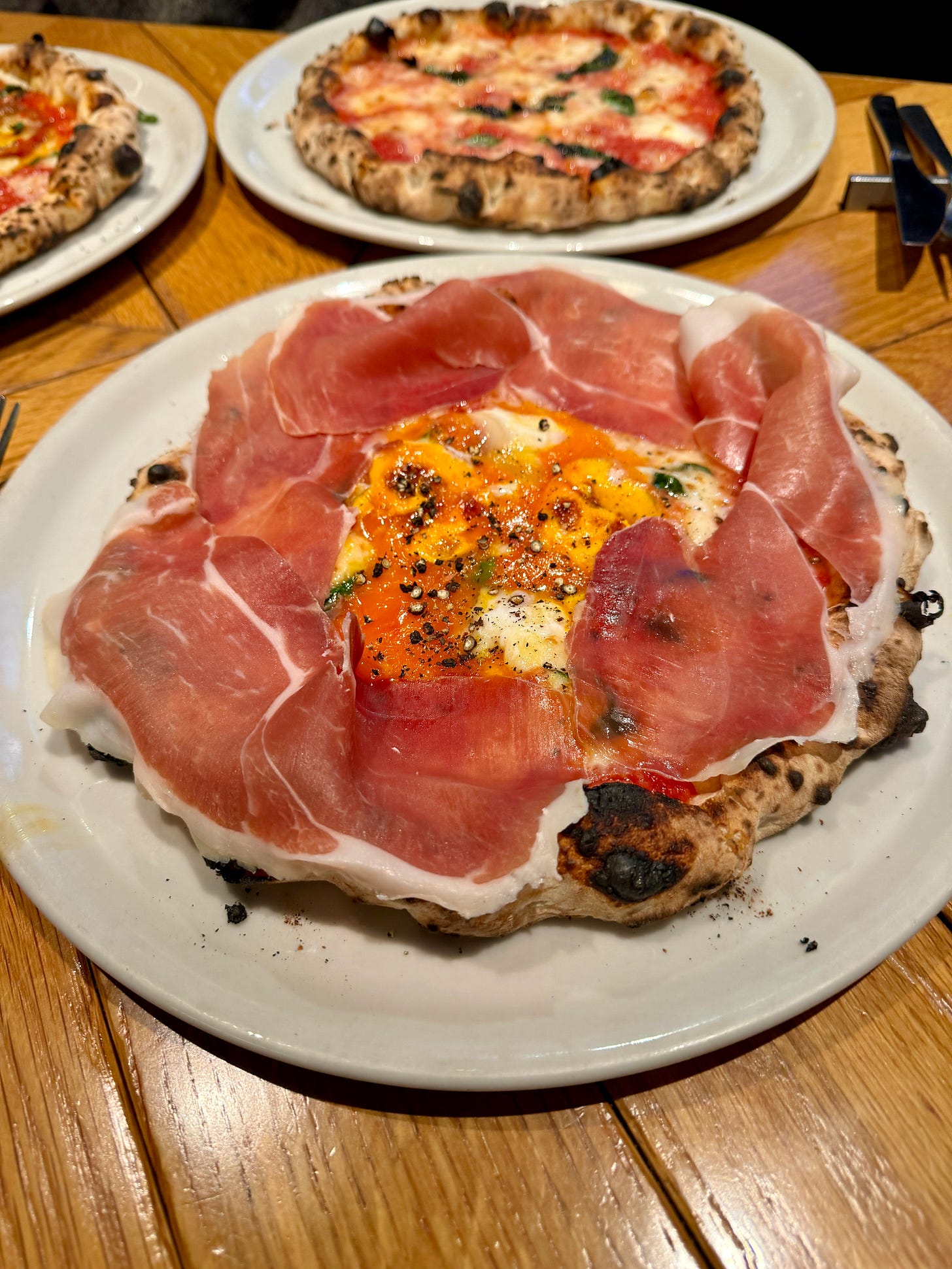READ WATCH PLAY FEAST - TOKYO
Highly idiosyncratic, hopelessly scattershot recs for first-time Tokyo travelers
I was asked by a member of our community for a Read Watch Play Feast focused on Tokyo and here’s my can-only-ever-scratch-the-surface attempt, aimed at first-time visitor types. In full transparency: I’ve been coming to Japan since 1998 and have visited upwards of 15 times (I need to figure the exact number). It’s the only place I’ve spent more time in outside of the United States and my birthplace, the Dominican Republic.
My Japan time is framed significantly by my adopted family on one side, and my interests and research into East-South exchanges on the other. Because I don’t speak, read, or write Japanese, my sense of Tokyo, of Japan, is weirdly distorted. To be clear: I am no expert. Also: the brother I was when I landed in Tokyo in 1998 is not the brother I am now. In those days I was broke af and spent what little money I had on Akira, clubs and eating — primarily gyudon, ramen, and curry (curry was always my favorite). Can’t imagine eating that many carbs, now that I can’t run or bike anymore, or staying up like that. Never seemed to sleep back then.
In a city whose greater metropolitan area encompasses 5,200 mi2 miles and 40 million plus people no list can hope to be remotely comprehensive. If you’re looking for itineraries or detailed round-up of top ramen / vintage / coffee spots, etc., this won’t be it: you’ll have better luck on social media. This is just a constellation of favorites that I hope will help someone.
Final Note: when it comes to eating in Tokyo my advice is pretty standard. Put together your list, sure, but also keep in mind you’re just as likely to find amazing spots wherever you shack up, unless you’re staying out in the boonies (and even then chances are you still might eat good). Wandering into restaurants in my experience often yields a lot more value, heart, and experience than the Instagram catch-me-if-you-can game — as long as you’re prepared to be turned away every now and then, because good places are booked in advance — and, sometimes, because proprietors aren’t willing / don’t feel up to the challenge of fucking with gaijin. Tokyo is such an endless bounty of culinary excellence you’re never far from the next best meal of your life, no matter what level you feast at. But never forget: if the spot looks popular chances are you’ll need to make a reservation.
So without further ado please find my very incomplete idiosyncratic scattershot of recommendations for Tokyo.
READ
If you’re like me before you travel you read and fortunately Japan delivers when it comes to its literature.
Here’s my No Murakami reading list. (If you want Murakami I’ve put some titles here). I’ve also left out manga, which I’ve been reading since I was a teenager, because it deserves its own post (but here are a few anyway: Otomo’s Akira, Miyazaki’s Nausicaä of the Valley of the Wind, Fumiyo Kouno’s Town of Evening Calm, Country of Cherry Blossoms, Umezu’s The Drifting Classroom, Mochizuki’s Dragon Head)
Natsuo Kirino’s Out is flat-out spectacular and my number one. A feminist crime thriller about a group of female coworkers conspiring to cover a murder and dispose of the body, Out also happens to be a scathing no-prisoner-taken-or-fucks-given critique of the interlocking ills infecting contemporary Japanese society. An un-put-down-able tour de force and sharp reminder that much of what visitors love about Japan is purchased on the back of tremendous, oft-invisible suffering.
Yoko Ogawa’s The Housekeeper and the Professor – the plot sounds Kdrama ridiculous — a mathematician whose memory was damaged in accident (and can only remember the last 90 minutes) takes on a new housekeeper and her baseball-obsessed son. Brief, gentle, heartbreaking, and my number two for short. I used to hand this novel out to everyone I knew who was interested in Japanese literature — a perfect gateway-er.
Hideo Yokoyama’s Six Four. If you have the patience for a slow-burning door-stop of a procedural about a long unsolved murder full of bureaucratic inside baseball and dogged unglamorous detective work, this novel really is dynamite. Deliberate and mesmerizing — my number two for long.
Akira Kurosawa’s Something like an Autobiography. As true a portrait of an artist as a young man as you’ll ever read, and for cineastes this inspiring memoir by one of the titans of film is a complete treasure. A book that will send you back to the mighty works that reshaped cinema.
Akemi Johnson’s Night in the American Village. To understand any country, it behooves you to understand its borders. Johnson takes us to Japan’s preeminent border — Okinawa — and beyond: to the fraught bloody borders between Okinawan women and the omnipresent US military bases. Johnson transforms history, reportage, and personal reflections into a fierce illumination.
Pico Iyer’s A Beginner’s Guide to Japan: Observations and Provocations. Fragmented and irreverent, but deep in insight and wonder. Pico Iyer is never not fascinating, but something happens when he writes about Japan — his already formidable powers become glorious.
Gerald Horne’s Facing the Rising Sun: African Americans, Japan, and the Rise of Afro-Asian Solidarity. Horne is prolific and piercing and wide-ranging, and I recommend reading everything he writes (as I do). Facing the Rising Sun tells a little-known history — well, I didn’t know about it — about the pro-Japanese sentiment among African Americans during the WW2. Black activists and nationalists of all stripes viewed Imperial Japan as an enemy of global white supremacy and some folks even looked forward to Japan invading the US so they could join in on Japan’s side. A fascinating counter-history, deftly-told, well researched.
Marié Abe’s Resonances of Chindon-ya: Sounding Space and Sociality in Contemporary Japan. Abe is an extraordinary scholar who uses chindon-ya — traditional street musicians who publicize businesses by parading around town — to launch a wide-ranging disquisition on the politics of protest, sound, community, precarity, authenticity, spatiality, and listening in post-war Japan.
If you’re looking to understand the war that still haunts Japan and animates its political system go for John Dower’s total classic Embracing Defeat or Ian W. Toll’s kinetic Pacific Crucible.
WATCH
Tampopo — I cannot express how deeply I was moved when I saw this masterpiece for the first time in college. My brother-in-heart Michi brought a copy with him back from Japan and the rest is history. A young charismatic Watanabe Ken opposite a remarkable Miyamoto Nobuko in a film so deliriously smart and feeling you have to experience it to believe it. Also, yes: ramen, but as a metaphor for life’s rich pageant. Director Itami Juzo died far too young.
Suo Masayuki’s Shall We Dance? The original, not the flat J.Lo / Gere remake. A burned-out salaryman is reborn when he decides to join a ballroom dancing class and becomes infatuated with one of its signature dancers. I can watch this one again and again and again and my heart always emerges bruised and strengthened, haunted and ecstatic, in equal measure. I come from a dance culture, so perhaps I’m extra-vulnerable to this film’s lyrical charm, but I’ll wager even the most lead-footed will be won over.
Yamashita Nobuhiro’s Linda Linda Linda. Bae Doona broke out in this girl-band coming-of-age winner that reminds us of that intoxicating bewildering time when we were all becoming. Every country should have its own Linda Linda Linda. Perfect double feature with Sori Fumihiko’s inventive Ping Pong. Also: Linda Linda Linda’s title song is a karaoke banger.
Kurosawa Kiyoshi’s Cure. An elliptical, mindbender that is part police procedure and part descent into hell, Cure is J-horror’s opening blast and despite later, better known films like Ringu, Cure has never been surpassed. Not in eeriness, not in intelligence, not in the nightmare whose revelation does little to dampen its disturbing force. Hashimoto Koji, star of Shall We Dance?, does a complete 180 here and confirms his astonishing range.
What can be said about Kurosawa Akira’s Ran? A magisterial re-telling of William Shakespeare’s King Lear set in the bloody madness of the Sengoku era, With its cast of thousands, operatic battle scenes, and a singular performance from Nakadai Tatsuya, Ran is for me the most perfect expression of cinema ever. Sublime epic from a soaring genius, no notes.
PLAY
Recommending Japanese music in brief is like using a sigh to describe a hurricane, but here’s the sigh that hopefully will lead someone to the edge of the hurricane.
Creepy Nuts’ Bling-Bang-Bang-Born
Misora Hibari’s Matsuri Mambo
Yellow Magic Orchestra’s Yellow Magic Orchestra
FEAST
Until the end of May 2025 the Mori Museum in Roppongi has a revelatory exhibit on Tezuka Osamu’s monumental lifework Hinotori (Phoenix). Not to be missed, and you get an unbeatable view of Tokyo to boot.
They also have a small perfect exhibit Tokyo Underground 1960-1970s - A Turning Point in Postwar Japanese Culture that explores the underground movement that burst to life (and faded just as quickly) in Japan during the 60s and 70s. The magazines, posters, and other ephemera on display are astonishing.
When I’m in Tokyo I always make my standard museum circuit, my very own stations of the cross. I hit the Pola Museum Annex, the Tokyo Photography Museum (one of my favorites), the Artizon, the National Art Center, and I always trek out to the Museum of Contemporary Art Tokyo (which is closed until the end of April), an excuse to kick around Kameido and Koto.
Best source for art happenings: https://www.tokyoartbeat.com/en
As for the culinary side there’s just too much to recommend, another “sigh in lieu of a hurricane” situation. Besides, the influencers got all this shit covered on social media. Coffee, desserts, bars, izakayas, cheap eats, ramen, yakiniku — they have all the lists curated to maximum effect.
Just a few comments, then, geographically influenced by where I stay.
Yes, it’s true. When eating out always order a drink with your meal, even if it’s cold tea. A lot of places expect it, and as many mom-n-pop restaurants have razor-thin profit margins you will be helping them out.
Yes, Harajuku Gyoza Lou is worth the visit. Touristy to the max, but an institution.
Kittan Gyoza’s lunch sets are the real deal and a nice place to regroup if you’re in Nakameguro.
But better still is Kan for a pricier, but superb, omakase.
All the gaijin are at Fuku and Marumo and Tofu Sorano for a reason.
If you’re out in Shimokitazawa, Songbook is a never-fail.
Classy okonomiyaki near Ebisu without having to travel to Kansai? Imari. (There’s two locations, so make sure you keep them straight and don’t make a rez at one branch and end up at the other.)
There isn’t a lot of Caribbean grub in Tokyo, but One Love Caribbean Kitchen in Shimo does some respectable Jamaican standards.
I also recommend Soul Food House in Azabu-Juban if you must have your chicken and waffles stat.
And if you’re in town for the weekend a good way to spend a Saturday or Sunday is to start at the Aoyama Farmer’s Market (food trucks!) and then work your way up from Omotesando to Harajuku and Cat Street and finish at Meiji Jingu Shrine / Yoyogi Park.
Certain folks can’t survive a week without a little salsa / bachata. El Cafe Latino in Roppongi is a reliable place and once you have a dance or two your partners will recommend other spots.
Again, my list is supremely subjective and does not attempt to compete with the influencers for ramen, yakitori, izakayas, bars, matcha ice cream etc (though if you’re looking for one of those, try Ralph & Sam’s Tokyo lists).
Less a map than a broken compass that you can use for parts, if your own compass has a gap or two. If any of our community have recommendations please feel free to throw those down in the comments.





![Out [Book] Out [Book]](https://substackcdn.com/image/fetch/$s_!M2gj!,w_1456,c_limit,f_auto,q_auto:good,fl_progressive:steep/https%3A%2F%2Fsubstack-post-media.s3.amazonaws.com%2Fpublic%2Fimages%2F52ee8ce0-890a-4f32-a3d0-de1072becab9_647x1000.jpeg)






What would you do if you were not writing Junot Diaz? You write about anything with delight, intensity and desire. I cannot imagine you without writing or writing without you.
Thanks so much!